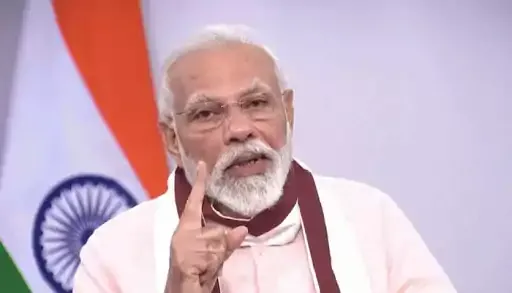Narendra Modi was sworn in as the Prime Minister of India on 26 May 2014 at the Rashtrapati Bhavan. He became the 14th Prime Minister of Republic of India and first prime minister to be born after India's independence from the British rule. His first cabinet consisted of 45 ministers, 25 fewer than the previous UPA government. 21 new ministers were added to the council of ministers in November 2014. His current cabinet has a strength of 78 ministers, which is one of the largest cabinets in recent years.
Narendra Modi, Prime Minister of India
The economic policies of Modi's government focused on privatisation and liberalisation of the economy, based on a neoliberal framework. Modi liberalised India's foreign direct investment policies, allowing more foreign investment in several industries, including in defence and the railways. Other reforms included removing many of the country's labor laws, to make it harder for workers to form unions and easier for employers to hire and fire them. These reforms met with support from institutions such as the World Bank, but opposition from scholars within the country. The labour laws also drew strong opposition from unions: on 2 September 2015, eleven of the country's largest unions went on strike, including one affiliated with the BJP. The Bharatiya Mazdoor Sangh, a constituent of the Sangh Parivar, stated that the reforms would hurt laborers by making it easier for corporations to exploit them.
In his first budget, Finance Minister Arun Jaitley promised to gradually reduce the budgetary deficit from 4.1% to 3% over two years, and to divest from shares in public banks. Over Modi's first year in office, the Indian GDP grew at a rate of 7.5%, making it the fastest growing large economy. For this the basis was a revised formula introduced a year after he took office, which surprised a lot of economists. However, this rate of growth had fallen significantly to 6.1%, even by the revised metric, by his third year in office. This fall has been blamed on the exercise of demonetisation of currency.
During the 2014 election campaign, Modi expressed hopes for a tenure without communal violence. The BJP sought to identify itself with political leaders known to have opposed Hindu nationalism, including B. R. Ambedkar, Subhas Chandra Bose, and Ram Manohar Lohia. The campaign also saw the use of rhetoric based on Hindutva, however, by BJP leaders in certain states. Communal tensions were played upon especially in Uttar Pradesh and the states of Northeast India. A proposal for the controversial Uniform Civil Code was a part of the BJP's election manifesto.
Source: wikipedia





